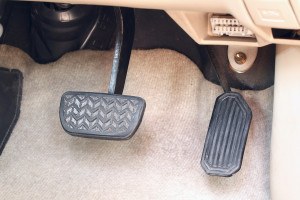Nearly 16,000 preventable crashes occur each year due to pedal error – when a driver mistakes the gas pedal for the brake pedal causing sudden vehicle acceleration. Pedal error crashes can cause injury to vehicle occupants, surrounding motorists, pedestrians and property. Earlier this summer the National Highway Traffic Safety Administration issued a safety advisory on reducing crashes caused by pedal error. The agency studied crash reports in North Carolina – the only state to track pedal misapplication.
 Pedal error commonly occurs when vehicles are traveling at low speeds, such as while parking. Drivers under 20 years of age and over 65 experience pedal error crashes about four times more frequently than other age groups, according to an NHTSA study.
Pedal error commonly occurs when vehicles are traveling at low speeds, such as while parking. Drivers under 20 years of age and over 65 experience pedal error crashes about four times more frequently than other age groups, according to an NHTSA study.
Instances of sudden acceleration have been linked to pedal error, where the driver believes he or she applied the brake instead of the gas pedal.
Contributing factors, according to the auto safety regulator, is the significant variation among vehicle makers on pedal placement as well as the fact that there is no globally accepted standard for regulating pedal placement.
Besides the location of the pedals, the agency found a high number of incidents related to specific makes of cars – certain model years of Honda Accords were matched to a high number of total incidents. Additional factors include driver age, gender and height as well as what action the driver was engaged in when the incident occurred. Seat position was also noted to be a contributing factor.
“During the analysis of this data, it was discovered that roughly half of the pedal misapplication events studied occurred while drivers were either turning the vehicle or reversing; actions that are generally associated with adjustments to drivers’ positions, suggesting that variations in driver positioning may influence pedal misapplication rates.
The model also indicated that a narrower seat width was associated with lower rates of pedal misapplication when pedal spacing was large,” stated the authors of the report.
Retail, Restaurants Hit Hard
Stories of drivers slamming into storefronts are regularly covered by local news media. In 2013, Texas A&M University research revealed that thousands of buildings are struck each year by errant vehicles. The Storefront Safety Council, which collects data on vehicle into building crashes, estimates commercial buildings sustain approximately 50 vehicle-into-building crashes per day.
The council found that the states with the highest number of licensed drivers over 65 also ranked highest for storefront crashes.
Two factors, in particular, influence the incidence of vehicle-into-building crashes, according to the council: driver demographics and parking lot configuration.
“Drivers of all ages commit pedal error: their foot slips from one pedal to the other, or they mistakenly press the gas instead of the brake. But pedal error is especially common among drivers aged 16 to 20 and those 76 and over, according to the NHTSA. The Texas A&M data show that as many as 40 percent of storefront crashes are a result of pedal error,” states the Storefront Safety Council’s website. “Even though California has 400,000 MORE licensed drivers than Florida, Florida’s drivers crash into commercial buildings, businesses, and non-residential structures at a rate that is 70 percent HIGHER than drivers in California! Our current estimate is that Florida accounts for as many as 17 percent of all such accidents nationally, and does so with just 10 percent of all licensed drivers,” the council’s website further noted.
The council’s data looked at incidents by site type and found that 25 percent of crashes occurred at retail stores, 22 percent at other locations, 21 percent at convenience stores and 19 percent at restaurants.
Protective barriers and education are two ways to reduce these types of errors, according to the NHTSA.
Some states and cities have released new standards to combat the potential of injuries and damage related to pedal error. Artesia, California and Massachusetts are just two examples where new standards were set in place in 2015.
Was this article valuable?
Here are more articles you may enjoy.

 Google Faces UK Class Action From Businesses Over Online Search Dominance
Google Faces UK Class Action From Businesses Over Online Search Dominance  LA Wildfires Had Little Impact on Reinsurer Risk Appetite During April Renewals
LA Wildfires Had Little Impact on Reinsurer Risk Appetite During April Renewals  Plane Carrying New York Lawmakers Clipped at Reagan Airport
Plane Carrying New York Lawmakers Clipped at Reagan Airport  Inspections of Affected Barrels Will Take Time as Flood Cleanup Progresses at Kentucky Distillery
Inspections of Affected Barrels Will Take Time as Flood Cleanup Progresses at Kentucky Distillery 